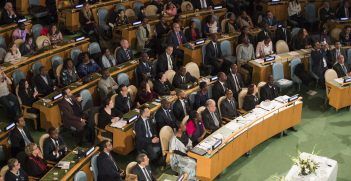India Tackles Black Money

On 8 November, India’s Prime Minister Narendra Modi introduced a policy of demonetisation. It was designed to tackle the pervasive role of black money in the economy and improve the nation’s fiscal position. The outcome has been to cause friction in the short term, but it will yield substantial benefits in the future.
At 8pm on 8 November, Indian Prime Minister Narendra Modi appeared on national TV to announce that in four hours’ time, at midnight, currency notes in the denomination of 500 and 1,000 rupees ($A9.80 and A$19.60), the two highest denomination Indian currency, would cease to be legal tender. Anticipating the panic that could ensue from this sudden announcement Modi patiently explained both the reasons for this sharp policy move and why honest citizens would only face some inconvenience for a few days but need not fear losing the value of their cash held in currency notes of these denominations.
Policymakers had two basic economic motives for carrying out the demonetisation. First, over a long period money that circulates outside the formal tax system—black money—had grown enormously, with most of it held in the form of 500 and 1,000 rupee currency notes. Total currency with the public at the time of Modi’s announcement was 16 trillion rupees (up from 4 trillion in 2006), of which 13.5 trillion rupees was held in currency notes of 500 and 1,000 denominations. Much of this black money is generated as a result of tax evasion schemes, such as in real estate transactions where the price of a house is drastically under-reported to reduce the registration fees paid. This black money is very pervasive in the economy, has a dynamic of its own, and feeds into many illegal and dangerous activities including money laundering, drug trafficking, stocking of gold, bribery, corruption, smuggling and terrorism, to mention just a few.
The second reason advanced for demonetisation is the prevention of large-scale counterfeiting of currency notes, especially of 500 and 1,000 denominations. The Reserve Bank of India (RBI) has warned the public repeatedly about this danger—the latest warning coming on 26 October this year. It was widely felt that such counterfeiting was becoming a serious threat to the stability of India’s financial system and needed to be brought to a sharp end. There was also evidence that these counterfeit notes were used to finance the same aforementioned illegal and dangerous activities.
A third motive for this demonetisation, although not stated, was political. During the campaigning for the 2014 parliamentary or Lok Sabha elections, which he won so decisively, Modi had vowed to eradicate black money from the economy. Although several laws related to addressing money laundering, illegal outflow of cash and the like had been enacted, a decisive step which would appeal to India’s vast electorate was missing. With assembly elections in five key states due in the next few month (and their implications for elections of the president and vice president, also due next year) the timing of this announcement was perfect from an electoral perspective. Modi is now seen as waging a decisive war against black money and corruption.
The modus operandi of the scheme is as follows. Currency notes in the denomination of 500 and 1,000 rupees can be deposited without any limit in customer bank accounts. All electronic and bank cheque-denominated transactions will proceed as usual. Cash withdrawals have been limited for a few days after which they will proceed normally. New 500 and 2,000 rupee notes (in limited numbers) with much advanced security features, making them almost impossible to counterfeit, have been introduced. Thus, if all transactions of a citizen are perfectly legal they would not face any difficulty beyond the discomfort of not being able to withdraw large amounts of cash in the first few days after the policy announcement.
The timing of this scheme was, however, not cynically populist. Indeed, it was very carefully planned. Given that many Indians traditionally do not have bank accounts, Modi’s government went on an aggressive drive of getting people to open bank accounts, even with zero balance under the Jana Dhana Yojana scheme. On 11 November 2016, 254 million such bank accounts with a total balance of over 453 billion rupees were in operation. So, even the common person with no previous bank account now has an avenue to deposit their 500 and 1,000 rupee notes. Those still without a bank account would now have an incentive to open one and enter the financial mainstream. They have until 30 December 2016 to deposit/exchange their 500 and 1,000 rupee bank notes.
Further, the government had given several months’ time (ending 30 September) under an amnesty scheme to holders of unaccounted cash to come clean and declare their assets, pay tax and a penalty, and not be charged.
So, there are now two sets of losers. Those depositing large amounts of unaccounted cash in their bank accounts will have to explain their sources of earning, something in which the income tax authorities would be interested. If no credible explanation is given, these persons will face charges of tax evasion. Second, those printing counterfeit Indian currency have been dealt a body blow and there should be a sharp drop in the illegal and dastardly activities this counterfeiting has hitherto been financing.
The adjustment to this new structure of India’s currency composition implies a period in which there is a reduced value of currency in circulation (hence reduced liquidity) meaning there could be a temporary drop in aggregate demand. This may marginally lower GDP growth for the third quarter of 2016-17, currently estimated at 7.8 per cent. However, with good monsoons there should be a sharp rise in agricultural output and rural incomes—so this effect would be quite short-term in nature.
Reduced liquidity and the attendant reduction in aggregate demand will also lead to lower inflation. Commercial banks will experience a sharp rise in deposits and reduced currency off-take. The RBI may address this imbalance in bank balance sheets by marginally increasing the Cash Reserve Ratio. The large increase in government revenue because of additional taxation income following the revelation of the hidden assets that are now coming forth as bank deposits, will ease fiscal pressures on the government and enable it to undertake substantial increases in public investment without compromising its fiscal targets. Lower inflation would permit interest rate cuts to further stimulate the economy.
India’s demonetisation policy has been accurately targeted towards a number of goals and has been well-executed. It will cause some frictional difficulties in the short-term but will yield substantial benefits in the medium- to long-term.
Professor Raghbendra Jha is the head of the Arndt-Corden Department of Economics, College of Asia and the Pacific, Australian National University.
This article is published under a Creative Commons Licence and may be republished with attribution.





